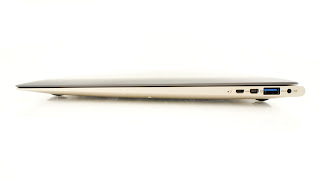When this
new piece of aluminium made its first debut, Windows lovers were thrilled.
There’s finally a Windows based ultraportable that can beat the AIR obsession. But does it? My first
look at the Zenbook suggested that it was just another Macbook clone that tried
too hard to outdo the Mac. However evidences show that there are some features
that make this ultrabook worth its effort and price.
First of
all, Zenbook has traits that consumers drool over; it’s super thin, just like
the Macbook Air (even thinner than the Lenovo’s U300s). It has a unibody
aluminium design, making its structure tougher and sexier (unlike the Acer
Aspire S3 which is plasticky). It has a speedy Core i5 or i7 processor (depends
on the model), and 128gig SSD, which grants it faster boot and resume times. It
also has a higher resolution display than the Macbook Air.
The
Bundled Goodies
The Zenbook
has come with a brown fabric sleeve, that looks more like a leather envelope, a
USB-to-Ethernet adapter, a micro-VGA-to-VGA adapter (save you some cash from
buying an adapter separately). The adapters also come with dedicated pouch. I do
hope that they include a micro- HDMI-to-HDMI adapter.
Keyboard
Something
worth mentioning about its keyboard is its brush aluminium keycap, compare to
Macbook Air’s black plastic keycap. However, a significant flaw that might keep
customers away is the low sensitivity of the keys. Many complaints that they
need to stroke the keys hard to make sure the presses are detected. It is also good if Asus can adapt the elegant
back-lit keyboard design which eases users for typing at low light condition(like
the Macbook Air, Macbook Pro, and HP Pavilion dv3510nr).
Touchpad/Trackpad
The Zenbook
UX31 touchpad is nearly as large as Macbook Air’s, making it more comfortable
to manoeuvre around. However scrolling
is still not as smooth as the Mac, and the two fingers scrolling and pinch to
zoom in/out gestures are somehow over sensitive. Asus can’t be blamed entirely
as this is also possibly due to the multi-touch patent that Apple made.
Display
Though Zenbook’s
screen resolution (1600 x 900) is higher than Macbook Air’s (1440 x 900), a
quick test at the showroom indicated that there some undesirable issues on
viewing angles. I need to really sit in front of the screen and adjust the
screen for the best viewing experience. The screen is also not as sharp as
expected.
Speakers
Packed with
B&O ICEpower and Asus signature SonicMaster, the speakers sound great,
despite the size of the Zenbook. (don’t expect it to be as good as the N
Series, as they have a larger resonance chamber)
Boot and
Resume
Well, I don’t
own one the Zenbook, so I can’t test on the boot and resume speed. But based on
the data stated, the boot speed of Zenbook running on Windows 7 Home Premium is
approximately 29 seconds, slightly slower than Macbook Air that runs on Lion.
It resumes instantly from sleep in about 2 seconds.
Conclusion:
If you
really want a Macbook Air alternative that runs on Windows, perhaps the Zenbook
is the gadget for you. But for me, with the touchpad and keyboard being an
essential part of an ultraportable, Asus still need to work harder on it. And I
really think that Asus, being a successful Taiwan-based company should stop making
nearly exact copy of the Mac design, and instead, focus on developing their own
unique identity in the ultrabook industry.
From what I can see, Asus has been doing great on its overall product
lines, having creative designs and robust performance; therefore, I don’t see
why they need to be involved in this imitating frenzy.






No comments:
Post a Comment